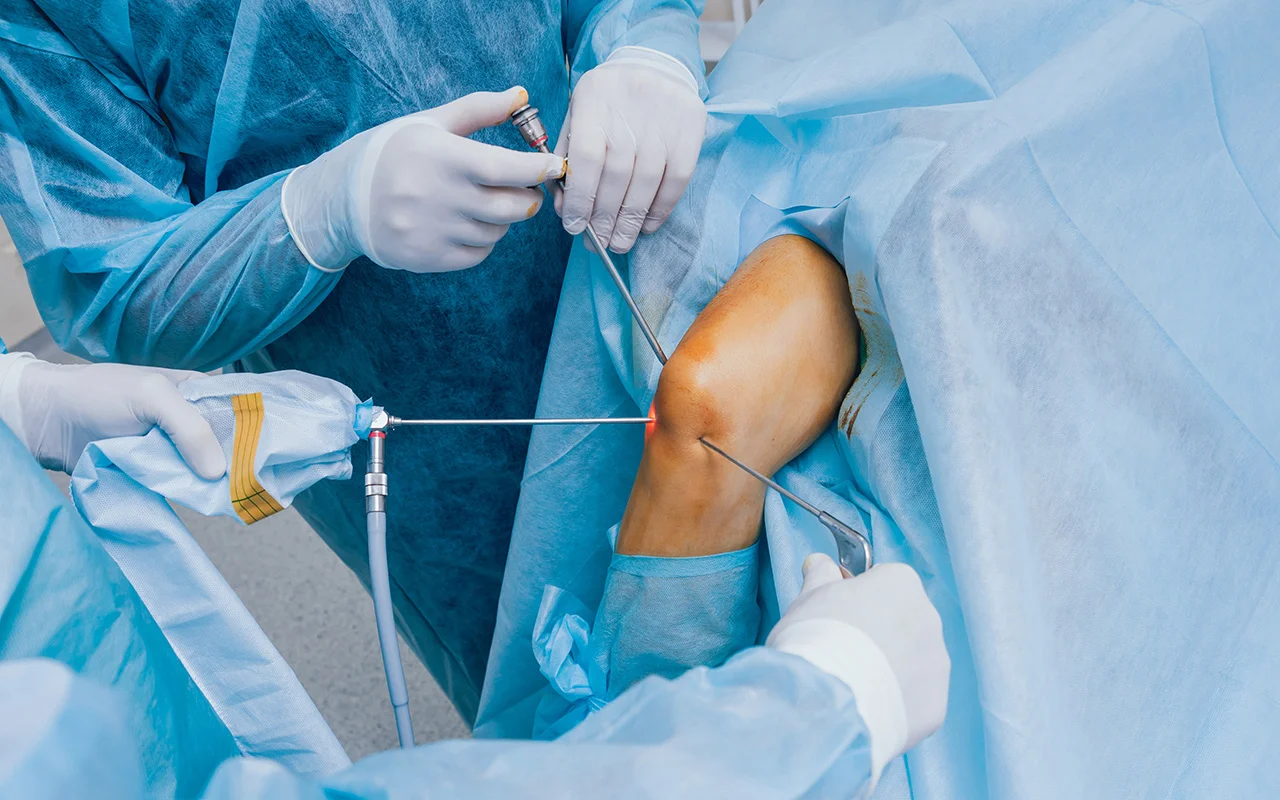
Knee Arthroscopy in Guntur
Best Knee Arthroscopy in Guntur, Andhra Pradesh, India
Happy Hospitals is known for Best Knee arthroscopy in Guntur offering safe and secure knee arthroscopy for past 20+ years. Knee Arthroscopy is a surgical procedure used to diagnose and treat various knee conditions. It involves inserting a small camera, called an arthroscope, into the knee joint through small incisions. The camera allows the surgeon to visualize the inside of the knee and perform necessary surgical procedures with specialized instruments.
Knee arthroscopy is commonly used as a diagnostic tool to evaluate and identify the cause of knee pain, swelling, or other symptoms. Arthroscopy Surgeon can directly visualize the structures within the knee, including the bones, cartilage, ligaments, and tendons, to assess any abnormalities or damage. Book Appointment with best arthroscopy surgeon in Andhra Pradesh.

Best Knee Arthroscopy Hospital in Guntur
Happy Hospital is recognised as the best Knee arthroscopy hospital in Guntur Andhra Pradesh. is a minimally invasive procedure that uses small incisions, typically ranging from ¼ to ½ inch. Compared to open surgery, this technique generally results in less tissue trauma, reduced pain, faster recovery, and smaller scars. Knee arthroscopy or arthroscopy in guntur can be used to perform various surgical procedures to treat specific knee conditions. Some of procedures that can be performed arthroscopically include:
Diagnostic Evaluation: Knee arthroscopy can be used to diagnose the cause of knee pain, swelling, or other symptoms when other non-invasive imaging tests such as X-rays or MRI scans have not provided a definitive diagnosis. By directly visualizing the structures inside the knee joint, the surgeon can identify any abnormalities or injuries that may be causing the symptoms.
Meniscus Tears: One of the most common reasons for knee arthroscopy is to diagnose and treat meniscus tears. The surgeon can evaluate the type, location, and severity of the tear and then either repair the tear or trim and remove the damaged part of the meniscus.
Ligament Injuries: Knee arthroscopy may be performed for the treatment of ligament injuries, such as anterior cruciate ligament (ACL) or posterior cruciate ligament (PCL) tears. The surgeon can assess the extent of the injury and perform techniques like ligament reconstruction or repair.
Cartilage Injuries: Arthroscopy can be used to evaluate and treat cartilage injuries or defects in the knee joint. Techniques like cartilage shaving, microfracture, or cartilage transplantation may be performed to promote cartilage healing and restore joint function.
Removal of Loose Bodies or Debris: If there are loose bodies (small fragments of bone or cartilage) or debris floating within the knee joint, arthroscopy can be used to remove them. These loose bodies can cause pain, swelling, and mechanical symptoms, and their removal can alleviate these symptoms.
Synovial Biopsy or Synovectomy: In cases of synovial inflammation or conditions like rheumatoid arthritis or synovial chondromatosis, knee arthroscopy may be performed for a synovial biopsy (taking a tissue sample) or synovectomy (removal of inflamed synovial tissue).
Evaluation of Unexplained Knee Symptoms: Knee arthroscopy may be done when there are unexplained knee symptoms or persistent knee problems that have not responded to conservative treatment. It allows for a thorough evaluation of the knee joint to identify any underlying issues that may require treatment.
Recovery and Rehabilitation
Recovery from knee arthroscopy is typically faster compared to open surgery. The small incisions require minimal stitches or adhesive strips, and patients can often go home on the same day or the following day. Rehabilitation exercises, including physical therapy, are typically prescribed to restore knee strength, flexibility, and function.
Risks and Complications
While knee arthroscopy is generally considered safe, like any surgical procedure, there are potential risks and complications. These may include infection, blood clots, nerve or blood vessel damage, persistent pain, or stiffness. However, such complications are rare. Happy Hospitals which is the best known name for Knee Arthroscopy in Guntur by top Arthroscopy Surgeon in Guntur, Andhra Pradesh, India Dr Sivaiah Potla takes special and personalised care to minimise the risk and to enable patients walk with happy joints.

Knee arthroscopy is suitable for a range of knee conditions, but it is not the appropriate treatment for all cases. The decision to undergo knee arthroscopy is made after a thorough evaluation by Best Knee Arthroscopy Surgeon, considering factors such as the nature of the knee problem, medical history, imaging results, and the patient's symptoms and goals.
Advantages of Arthroscopy
Knee arthroscopy in Guntur offers several advantages compared to traditional open knee surgery. Here are some of the key advantages of knee arthroscopy:
Minimally Invasive: Knee arthroscopy is a minimally invasive procedure that involves small incisions and the use of an arthroscope (a small camera) to visualize and treat the inside of the knee joint. This results in less tissue trauma, reduced pain, and faster recovery compared to open surgery.
Smaller Incisions and Scars: The incisions made during knee arthroscopy are typically small, ranging from ¼ to ½ inch in size. These smaller incisions result in smaller scars, which are generally less noticeable and more cosmetically appealing.
Reduced Tissue Trauma: The minimally invasive nature of knee arthroscopy allows for minimal disruption to the surrounding soft tissues, such as muscles, tendons, and ligaments. This can result in less post-operative pain, swelling, and muscle damage compared to open surgery.
Faster Recovery: Knee arthroscopy typically involves a faster recovery period compared to open surgery. The smaller incisions and reduced tissue trauma contribute to quicker healing and a faster return to normal activities.
Shorter Hospital Stay: Knee arthroscopy is often performed on an outpatient basis, meaning that patients can typically go home on the same day of the procedure. This eliminates the need for an extended hospital stay and allows for recovery in the comfort of one's own home.
Reduced Risk of Complications: Knee arthroscopy is generally associated with a lower risk of complications compared to open knee surgery. The smaller incisions and reduced tissue trauma minimize the risk of infection, blood loss, blood clots, and other surgical complications.
Versatility: Knee arthroscopy allows for a wide range of surgical procedures to be performed within the knee joint. It can be used for diagnostic purposes as well as the treatment of various knee conditions, including meniscus tears, ligament injuries, cartilage problems, and synovitis.
Improved Visualization and Precision: The arthroscope used in knee arthroscopy provides a clear and magnified view of the structures inside the knee joint. This allows the surgeon to have a detailed visualization and perform precise surgical techniques, leading to better surgical outcomes.
Ideal candidate for knee arthroscopy
The ideal candidate for knee arthroscopy is typically determined by an orthopaedic surgeon based on various factors. While the final decision depends on individual circumstances, here are some general criteria that may indicate suitability for knee arthroscopy:
Knee Pain or Symptoms: The candidate should have persistent knee pain, swelling, or other symptoms that have not responded to Knee Preservation Treatment such as rest, physical therapy, medications, or injections.
Diagnostic Uncertainty: If non-invasive imaging tests such as X-rays or MRI scans have not provided a definitive diagnosis, arthroscopy may be recommended to directly visualize the structures inside the knee joint and determine the underlying problem.
Knee arthroscopy: is commonly performed for certain knee conditions, including meniscus tears, ligament injuries (such as ACL or PCL tears), cartilage injuries, loose bodies in the joint, and synovial problems.
Failed Preservation Treatments: If the candidate has undergone a course of Joint Preservation Treatments without significant improvement in symptoms or function.
The candidate should generally be in good overall health, with no significant medical conditions that would increase the risks associated with surgery and anaesthesia. Factors such as age, medical history, and the absence of uncontrolled diabetes, heart disease, or other conditions are considered.
The candidate should have realistic expectations regarding the potential benefits and limitations of knee arthroscopy. They should understand that arthroscopy aims to alleviate symptoms and improve knee function but may not fully restore the knee to its pre-injury state in all cases.
It's important to consult with Top Anthroscopic Surgeon in Guntur for a comprehensive evaluation of your knee pain and knee condition. They will assess your specific circumstances, medical history, imaging results, and symptoms to determine if knee arthroscopy is the appropriate course of action for you.
Arthroscopy in Guntur
Arthroscopy is a minimally invasive surgical procedure used to diagnose and treat joint problems including injuries in the knee, shoulder and hip. In Guntur, Dr Sivaiah Potna at Hospitals is renowned for the best Arthroscopy surgery in Guntur, Andhra Pradesh. He has gained a reputation for his expertise in this field in the last 20 years. Using advanced technology like Robotic surgery, Dr. Sivaiah offers precise and effective Arthroscopy treatments for joint pain, ligament tears and cartilage damage. Arthroscopy allows for quicker recovery times, minimal scarring, and less postoperative pain compared to traditional surgery. Patients trust Dr. Sivaiah for his excellent outcomes, making him the preferred choice for arthroscopic in Guntur.
Best arthroscopy surgeon in Andhra pradesh
When it comes to arthroscopic surgery in Andhra Pradesh, Dr. Potla Sivaiah is widely regarded as the best Arthroscopy surgeon in the Andhra Pradesh region. With years of experience and a commitment to utilizing the latest minimally invasive techniques, Dr. Sivaiah provides top-tier care for joint issues such as ligament tears, cartilage damage, and other orthopedic conditions. Arthroscopy, a key procedure in Dr. Sivaiah's practice, involves small incisions and specialized tools, resulting in faster recovery, minimal scarring, and reduced post-operative pain. His expertise has earned him the trust of patients throughout Andhra Pradesh, making him the go-to surgeon for arthroscopic treatments.
FAQ’s
Dr. Potla Sivaiah is widely recognized as the premier knee arthroscopy surgeon in Guntur. With extensive expertise and a stellar reputation, Dr. Sivaiah stands out for his exceptional surgical skills and patient care. He specializes in knee arthroscopy, offering advanced techniques for treating various knee conditions including ligament tears, cartilage injuries, and meniscal tears. Patients commend Dr. Sivaiah for his compassionate approach and dedication to delivering optimal outcomes. His commitment to excellence and comprehensive understanding of knee disorders make him the top choice for individuals seeking quality orthopedic care in Guntur, earning him widespread respect and admiration in the medical community.
Recovery after knee arthroscopy varies depending on the individual's condition and the extent of the procedure. Typically, patients can expect a gradual recovery spanning several weeks to months. Dr. Potla Sivaiah, a renowned knee arthroscopy surgeon, emphasizes personalized rehabilitation plans tailored to each patient's needs. Initially, patients may experience swelling and discomfort, requiring pain management and rest. Physical therapy plays a crucial role in restoring strength and mobility. With diligent adherence to post-operative instructions and rehabilitation exercises, patients can often resume light activities within a few weeks and achieve full recovery within three to six months under Dr. Sivaiah's expert guidance.
Contact Top Arthroscopy Surgeon in Guntur
Seeking the expertise of the best arthroscopy surgeons in guntur for Knee treatment, sports injuries treatment, loose bodies, ligament reconstruction, ACL and PCL, then look no further than Best Hospital for Knee arthroscopy in Guntur with best Arthroscopy Surgeon Dr Sivaiah Potla and his team of professional surgeons. Our accomplished knee arthroscopy surgeons are dedicated to transforming lives through advanced knee replacement procedures. To schedule a consultation at best Arthroscopy Hospital and embark on your journey towards improved mobility, you can easily book an appointment through our website: Happy Hospitals Booking. If you prefer a more direct approach, feel free to contact us at +91 9030797989. Our team is ready to assist you in securing an appointment and answering any inquiries you may have. At Happy Hospitals, we prioritize your comfort and well-being, ensuring a seamless and personalized experience from the moment you reach out. Trust us to provide unparalleled care with the best arthroscopy surgeons, combining expertise, compassion, and cutting-edge medical technology to ensure the best possible outcome for your knee health. Your journey to pain-free living begins with a simple click or call.
.webp)
.webp)





